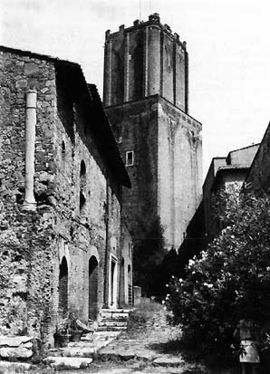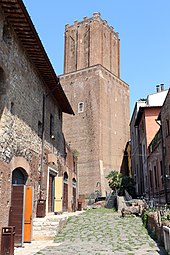History
The tower gained the popular nickname of "Nero's Tower" from a tradition that it originated as an ancient Roman construction from which the emperor Nero watched the Great Fire of Rome – this is derived from the classical account that he watched from a tower in the Gardens of Maecenas, though more trustworthy accounts place him out of town, at Antium at the time.
The actual construction of the tower probably dates to the time of Pope Innocent III (1198–1216) under the Aretino family. At the end of the 13th century, the tower was a possession of the powerful Annibaldi family, who were followed by the Prefetti di Vico and by the Caetani, Pope Boniface VIII's family. Under the Caetani the fortified quarter was enlarged and strengthened, probably rivalling Castel Sant'Angelo as Rome's main fortress.
At the end of the 13th century when Henry VII of Luxembourg came to Rome for his coronation as Holy Roman Emperor (May–June 1312), he chose the Torre delle Milizie as the base for his Ghibelline supporters. Twenty years later the tower was ceded to the Conti. During their ownership, Raphael, in his role as curator of the antiquities of the city, cited the tower as an example of an edifice built reusing antique parts. The Conti held the tower until 1619, when it was acquired by the nuns of the neighboring convent (later demolished) of Santa Caterina a Magnanapoli.
In 1911, the tower was declared an Italian National Monument.

Anagni is an ancient town and comune in the province of Frosinone, Latium, in the hills east-southeast of Rome. It is an historical and artistic centre of the Latin Valley.

Cisterna di Latina is a town and comune in the province of Latina in Lazio, of central Italy. It was the scene of the Battle of Cisterna in January 1944.

The Papal Basilica of Saint Paul Outside the Walls is one of Rome's four major papal basilicas, along with the basilicas of Saint John in the Lateran, Saint Peter's, and Saint Mary Major, as well as one of the Seven Pilgrim Churches of Rome.

San Gimignano is a small walled medieval hill town in the province of Siena, Tuscany, north-central Italy. Known as the Town of Fine Towers, San Gimignano is famous for its medieval architecture, unique in the preservation of about a dozen of its tower houses, which, with its hilltop setting and encircling walls, form "an unforgettable skyline". Within the walls, the well-preserved buildings include notable examples of both Romanesque and Gothic architecture, with outstanding examples of secular buildings as well as churches. The Palazzo Comunale, the Collegiate Church and Church of Sant' Agostino contain frescos, including cycles dating from the 14th and 15th centuries. The "Historic Centre of San Gimignano" is a UNESCO World Heritage Site. The town also is known for saffron, the Golden Ham, pecorino cheese and its white wine, Vernaccia di San Gimignano, produced from the ancient variety of Vernaccia grape which is grown on the sandstone hillsides of the area.

Alatri is an Italian town and comune of the province of Frosinone in the region of Lazio, with c. 30,000 inhabitants. An ancient city of the Hernici, it is known for its megalithic acropolis.

Velletri is an Italian comune in the Metropolitan City of Rome, approximately 40 km to the southeast of the city centre, located in the Alban Hills, in the region of Lazio, central Italy. Neighbouring communes are Rocca di Papa, Lariano, Cisterna di Latina, Artena, Aprilia, Nemi, Genzano di Roma, and Lanuvio. Its motto is: Est mihi libertas papalis et imperialis.
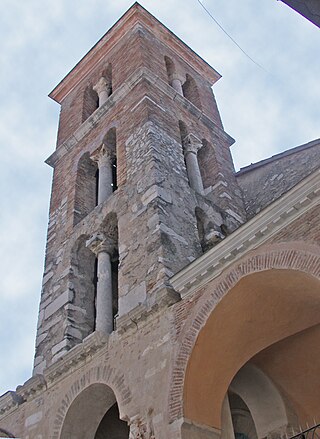
Minturno is a city and comune in southern Lazio, Italy, situated on the north west bank of the Garigliano.

The Palazzo Venezia or Palazzo Barbo, formerly Palace of Saint Mark, is a large early Renaissance palace in central Rome, Italy, situated to the north of the Capitoline Hill. Today the property of the Republic of Italy it houses the National Museum of the Palazzo Venezia. The main (eastern) facade measures 77 metres in length, with a height of about 31 metres. The north wing, containing the "Cibo Apartment", extending westwards, measures 122 metres in length. It covers an area of 1.2 hectares and encloses two gardens and the Basilica of Saint Mark. It was built in the present form during the 1450s by Cardinal Pietro Barbo (1417-1471), titular holder of the Basilica of Saint Mark, who from 1464 ruled as Pope Paul II. Barbo, a Venetian by birth as was customary for cardinals of the Basilica of Saint Mark, lived there even as pope and amassed there a great collection of art and antiquities. During the first half of the 20th century it became the residence and headquarters of the fascist dictator Benito Mussolini, who made notable orations from its balcony to huge crowds filling the Piazza Venezia.
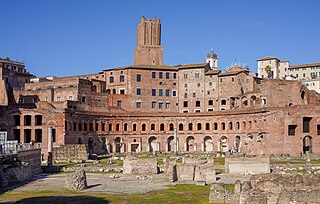
Trajan's Market is a large complex of ruins in the city of Rome, Italy, located on the Via dei Fori Imperiali, at the opposite end to the Colosseum. The surviving buildings and structures, built as an integral part of Trajan's Forum and nestled against the excavated flank of the Quirinal Hill, present a living model of life in the Roman capital and a glimpse at the restoration in the city, which reveals new treasures and insights about ancient Roman architecture.

Alife is a town and comune in the Province of Caserta (Campania), Italy. It is located in the Volturno valley, and is a flourishing centre of agricultural production. The comune was formerly inhabited by Arbëreshë and Jewish communities, who have since assimilated.

The Basilica of Maxentius and Constantine, sometimes known as the Basilica Nova—meaning "new basilica"—or Basilica of Maxentius, is an ancient building in the Roman Forum, Rome, Italy. It was the largest building in the Forum, and the last Roman basilica built in the city.

The Basilica of St. Bartholomew on the Island is a titular minor basilica, located in Rome, Italy. It was founded in 998 by Otto III, Holy Roman Emperor and contains the putative relics of St. Bartholomew the Apostle. It is located on Tiber Island, on the site of the former temple of Aesculapius, which had cleansed the island of its former ill-repute among the Romans and established its reputation as a hospital, continued under Christian auspices today.
Sgurgola is a comune (municipality) in the Province of Frosinone in the Italian region Lazio, located about 60 kilometres (37 mi) southeast of Rome and about 15 kilometres (9 mi) west of Frosinone.

The Towers of Bologna are a group of medieval structures in Bologna, Italy. The two most prominent ones remaining, known as the Two Towers, are a landmark of the city.

The Torre dei Conti is a medieval fortified tower in Rome, Italy, located near the Colosseum and the Roman Forum. The tower was one of the most impressive towers that dominated medieval Rome.

The Tomb of Caecilia Metella is a mausoleum located just outside Rome at the three mile marker of the Via Appia. It was built during the 1st century BC to honor Caecilia Metella, who was the daughter of Quintus Caecilius Metellus Creticus, a consul in 69 BC, and the wife of Marcus Licinius Crassus who served under Julius Caesar and was the son of the famous triumvir with the same name, Marcus Licinius Crassus. The mausoleum was probably built in 30–10 BC by her son who also had the same name, Marcus Licinius Crassus.

The Mausoleum of Helena is an ancient building in Rome, Italy, located on the Via Casilina, corresponding to the 3rd mile of the ancient Via Labicana. It was built by the Roman emperor Constantine I between 326 and 330, originally as a tomb for himself, but later assigned to his mother, Helena, who died in 330.
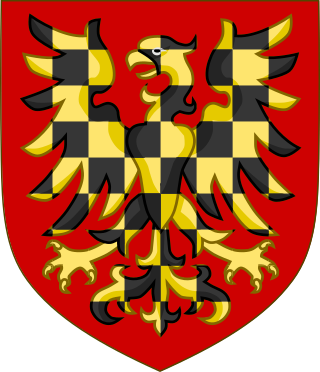
The counts of Segni were an important noble family of medieval and early modern Italy originating in Segni, Lazio. Many members of the family acted as military commanders or ecclesiastical dignitaries, including many cardinals and four popes.

The Appian Way Regional Park is the second-largest urban park of Europe, after Losiny Ostrov National Park in Moscow. It is a protected area of around 4580 hectares, established by the Italian region of Latium. It falls primarily within the territory of Rome but parts also extend into the neighbouring towns of Ciampino and Marino.
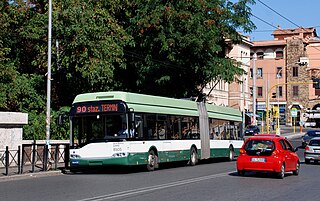
Municipio Roma III is the third administrative subdivision of Rome (Italy).
